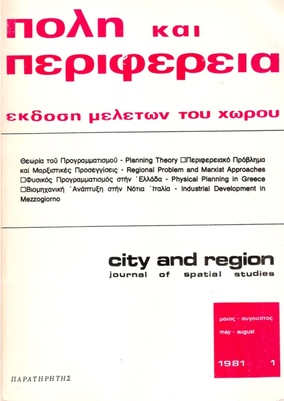[Abstract Title:] The spatial structure of capital : The case of Thessaloniki
Part of : Πόλη και περιφέρεια : έκδοση μελετών του χώρου ; No.13, 1987, pages 135-136
Issue:
Pages:
135-136
Parallel Title:
The spatial structure of capital : The case of Thessaloniki
Section Title:
Περιλήψεις συνεδρίου
Author:
Abstract:
This paper is oriented towards the analysis of the spatial aspects of industry in the Thessaloniki area, within the wider framework on the spatial organisation of the economy and the population of the area. The focus of the analysis is the examination of the location processes and structures, through which an attempt will be made to contribute to location theory, seen as indissolubly related to the theory of spatial organisation. On the basis of a distinction between empirical space and the analytical spaces which can be abstracted on the basis of it, it is argued that these analytical spaces can be seen as following from the articulation of the components of the social formation with geographical space. After the presentation of the branch structure of Thessaloniki in relation to the national developments and their repercussions on industrial location in the area, a series of economic spaces and an aspect of the political space and examined. The association of these spaces allows a theoretical construction of the Thessaloniki area, which both is suitable for the analysis of industrial location and corresponds to the empirical organisation of the area. Existing statistical data show a dramatic "decentralisation" of industry during the last decade, contrary to the population distribution that remained stable, which leads to an increased spatial polarization between production and consumption. While arguing that decentralization on the urban scale is really supercentralisation, an association is made between the locational tendencies of industry and the modes of capital accumulation. On the basis of the characteristics of the industrial system of the area - open in respect to flows, weak branch circuits, interior control –the hypothesis is made that among these only the openness of flows can be a factor inflencing location. This hypothesis on the speeding up of the circulation time of capital is tested, together with the influence of a series of indices, related to the productive forces and the relations of production, on location. The sectoral and concentric spatial distribution of these indices allows the explanation of the locational tendencies of industry and leads to the discovery of the fundamental spatial structure of the Thessaloniki area. Finally, the explanation of this spatial structure is completed with the analysis of the influence of state intervention and the ideology of the industrialists on the industrial location process.
Subject:
Subject (LC):
Notes:
Περιλήψεις των παρουσιάσεων στο συνέδριο της ΛέσβουAbstracts of papers presented at the Lesvos conference




